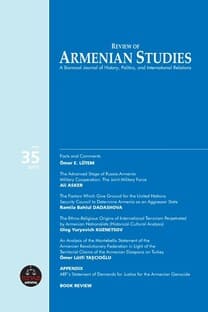THE RISE AND FALL OF ASALA AND ARMENIAN REVOLUTIONARY FEDERATION TERRORISM
(ASALA VE EDF TERÖRİZMİNİN ORTAYA ÇIKIŞI VE ÇÖKÜŞÜ)
___
Primary SourcesArmenian Terrorists, January 10, 1983, CIA, CIA-RDP88-01070 R000100520004-4
Patterns of International Terrorism: 1981, Department of State Bulletin Vol. 82, No. 2065 (August 1982):
Terrorism Review, CIA, July 29, 1985, CREST.
Terrorism Review, CIA, Dec. 14 1989, CIA Doc No/ESDN: 0000258747, CREST.
Terrorism Review, CIA, July 29, 1985 Secondary Sources
Contemporary Armenian Terrorism Terrorism: An International Journal Vol. 8, No. 3 (1986)
Transnational Armenian Activism, in Beyond the Soviet Union: the Fragmentation of Power, edited by Max Beloff, Brookefield, VT: Ashgate, 1997.
Transnational Sources of Support for Armenian Terrorism, Journal of Conflict Studies Vol. V, No. 4 (Fall 1985)
Alexander, Edward. A Crime of Vengeance: An Armenian Struggle for Justice, New York: Free Press, 1991.
Armenian Atrocities and Terrorism: Testimonies of Witnesses, Washington, DC: Assembly of Turkish American Associations, 1997.
Armenian Terrorism, Its Supporters, the Narcotic Connection, the Distortion of History, (Ankara, Turkey: Ankara University, 1984.
Avakian, Lindy V. Cross and the Crescent, Phoenix, AZ: USC Press, 1989.
Blaylock, Josh .Operation Nemesis: A Story of Genocide and Revenge, Devils Due Entertainment, 2015.
Bobelian, Michael. Children of Armenia: A Forgotten Genocide and the Century-Long Struggle for Justice, New York: Simon & Schuster, 2009.
Bogosian, Eric. Operation Nemesis: The Assassination Plot that Avenged the Armenian Genocide, New York: Little, Brown and Company, 2015.
Chaliand, Gerard and Arnaud Blin, eds. The History of Terrorism from Antiquity to Al Qaeda, Kindle Edition, Berkeley and Los Angeles, CA: University of California Press, 2007.
Corsun, Andrew. Armenian Terrorism: A Profile, in Department of State Bulletin Vol. 82, No. 2065 (August 1982)
Derogy, Jacques. Resistance and Revenge: The Armenian Assassination of the Turkish Leaders Responsible for the 1915 Massacres and Deportations, New Brunswick, NJ: Transaction Publishers, 1990.
Dionne, E.J. Jr., Armenian Terror: Tangle of Motives, New York Times, August 1, 1983.
Dugan, Laura et. al., Sudden Desistance from Terrorism: The Armenian Secret Army for the Liberation of Armenia and the Justice Commandos of the Armenian Genocide, in Dynamics of Asymmetric Conflict Vol. 1, No. 3 (November 2008)
Feigl, Erich. A Myth of Terror Exposed: Armenian Extremism, its Causes and its Historical Context, Freilassing, AT: Edition Zeitgeschichte, 1987.
Gunter, Michael M. Pursuing the Just Cause of their People: A Study of Contemporary Armenian Terrorism, Westport, CT: Greenwood Press, 1986.
Gunter, Michael M. Armenian Terrorism: A Reappraisal, The Journal of Conflict Studies Vol. XXVII, No. 2 (Winter 2007)
Henze, Paul. GOAL: Destabilization: Soviet Agitational Propaganda, Instability and Terrorism in NATO South, Marina del Rey, CA: European Institute for Security Research, 1981.
Howe, Marvin. Turks Blame Cypriots for Attacks in Name of Armenians, New York Times, February 28, 1980.
Kelly, Michael J. The Media and Terrorism: An Examination of News Coverage of Armenian Terrorism in Canada, PhD Diss., Carleton University, 1987.
Kurz, Anat and Ariel Merari. ASALAIrrational Terror or Political Tool, Boulder, CO: Westview Press, 1985.
MacCurdy, Marian Mesrobian. Sacred Justice: The Voices and Legacy of the Operation Nemesis, Brunswick, NJ: Transaction Publishers, 2015.
Mango, Andrew. Turkey and the War on Terror: For Forty Years We Fought Alone, New York: Routledge, 2005.
Melkonian, Markar. My Brothers Road: An Americans Fateful Journey to Armenia, New York: I.B. Tauris, 2007.
Minassian, Gaïdz. Guerre et Terrorisme arméniens, Paris: Presses Universitaires de france, 2002.
Moussault, Paul and Barbara Sahakian. ASALA, de Nemesis voor de Armeense genocide - Stadsguerrilla tegen Turkije (1975-1988), Netherlands: Papieren Tijger, 2015.
Panossian, Razmik. The Armenians: From Kings and Priests to Merchants and Commissars, London: Hurst & Company, 2006.
Shiragian, Arshavir The Legacy: Memoirs of an Armenian Patriot, Boston: Hairenik Press, 1976.
Şimşir, Bilal N. Şehit Diplomatlarımız (1973-1994), Vol. 2, Ankara, Turkey: Bilgi Yayınevi, 2000.
Tamkoç, Metin. International Terrorism: The Russian Connection, in Armenian Terrorism, Its Supporters, the Narcotic Connection, the Distortion of History, Ankara, Turkey: Ankara University, 1984.
Toumani, Melanie. There Was and There Was Not: A Journey Through Hate and Possibility in Turkey, Armenia, and Beyond, New York: Metropolitan Books, 2014.
Waal, Thomas de. Great Catastrophe: Armenians and Turks in the Shadow of Genocide, New York: Oxford University Press, 2014.
Yeghiayan, Vartkes. The Case of Misak Torlakian, Glendale, CA: Center for Armenian Remembrance, 2006.
Yeghiayan, Vartkes. The Case of Soghomon Tehlirian, 2nd Edition Glendale, CA: Center for Armenian Remembrance, 2006.
- ISSN: 1303-5304
- Yayın Aralığı: 2
- Başlangıç: 2002
- Yayıncı: Terazi Yayıncılık Basım Dağıtım Danışmanlık Eğitim Organizasyon Matbaacılık Kırtasiye Tic. Ltd. Şti.
SEVR’DEN LOZAN’A: ERMENİ SORUNU 1920-23
HISTORIOGRAPHY AND THE FUTURE OF MULTICULTURALISM IN EUROPE: PERİNÇEK V. SWITZERLAND
FROM SEVRES TO LAUSANNE: THE ARMENIAN QUESTION (1920-23)
THE ARMENIAN FORCED RELOCATION: PUTTING AN END TO MISLEADING SIMPLIFICATIONS
A CENTURY LATER: TOWARDS TURKISH-ARMENIAN RAPPROCHEMENT?
MÜKEMMEL ETNOSID: BAS KROMHOUT'UN ‘MÜKEMMEL SOYKIRIM' YAZISININ DEĞERLENDIRMESI
